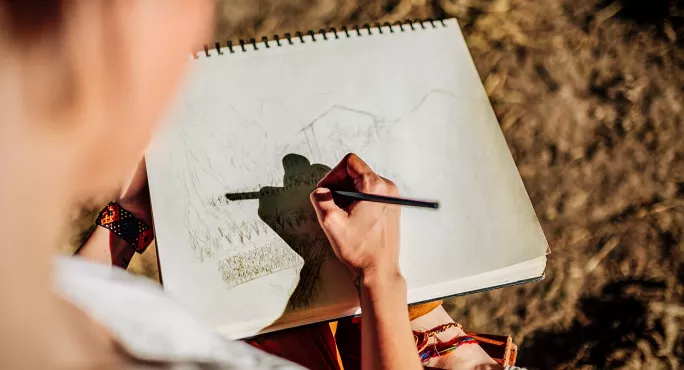How we use the arts to give students ‘real world’ experience

As a central part of the independent review into qualifications and assessment, Professor Louise Hayward suggested that a Scottish Diploma of Achievement would encourage a move toward a more vocational, real-world experience for pupils.
The expressive arts department at West Calder High School has spent the past three years aiming to expand its curricular offer to do just this.
While the traditional subjects of art and design, music and photography are still offered with their corresponding Scottish Qualifications Authority qualifications as an end point, the department has forged a pathway of creative thinking and project-based learning for students who wish to explore this more vocational - some might say relevant - subject matter.
- Related: Why now is a crucial time for the creative arts in schools
- England: Arts education at ‘crisis point’
- Data: Why arts subjects were hit so hard in the pandemic
- Context: What type of education reform is best for Scotland?
The department has developed a pathway from S1 to S6 with these challenge-based experiences, and the accompanying skills developed within, at their core. We have worked closely with Daydream Believers, a company that produces free, exquisitely designed resources with other companies such as Lego, Rockstar and the Ellen MacArthur Foundation.
The journey begins in S1 with an interdisciplinary project that challenges students with setting off on a hypothetical voyage of their own design to the Galapagos Islands. Then, they are shipwrecked on the mysterious “Solarpunk Island”.
Using the ethos of the solarpunk movement and the 15-minute city theory, islanders (that is, students) will work to create an island community that prioritises building a sustainable future. They can only use materials that they have theoretically packed, were present on their ship or are native to the island.
A voyage of curriculum innovation
Solarpunk Island is a pilot experience in which Daydream Believers has worked closely with Education Scotland. The original idea was that it would be a Steam (science, technology, engineering, the arts and mathematics) experience, developed ideally with a collaboration between art and design and science departments. At West Calder High, we dared to dream a little larger.
West Calder High delivers the project across S1 and S2, with islanders receiving two periods of the project per week in S1 and one in S2. Tribe leaders (teachers) have been timetabled to teach their islanders together in clusters of three or four, to allow for larger group working in some of the more experiential learning spaces.
Professionals from most, if not all, departments across the curriculum deliver the project in a collaborative manner that allows the young people to lead their own learning. As the year unfolds, every group of islanders will have the opportunity to experience Solarpunk Island within our outdoor learning curriculum; they will also be given the unique experience of “failing and fixing”, one of the core Daydream Believers skills.
As part of the project, and in line with the suggestion of the “personal pathway” envisaged by the Hayward review, islanders will reflect upon eight core skills that they will work on throughout the project. Islanders are given their own individual sketchbooks within which they can explore the project in whichever way suits them best, encouraging a truly individualised approach.
That will be the primary vehicle for self-reflection. They will, however, also be encouraged to complete a digital passport, identifying their new skills and how they can be explored in wider contexts.
In light of the publication of the review of qualifications and assessment, Professor Hayward, along with the curriculum innovation team from Education Scotland, was invited to see Solarpunk Island in action and to explore the wider creative pathway established by the expressive arts department.
Both Professor Hayward and Joan Mackay, head of curriculum innovation at Education Scotland, have commented very positively on the work at West Calder High. They noted enthused students and staff who were truly engaged in the project, and deep, meaningful learning with clear real-world implications.
In one learning episode, for example, islanders are assigned a section of the island where they can do/build/create anything they like, using only the materials that existed on the island, were present in their luggage or could have been present on a freight cruiser. By allowing the islanders autonomy in serving their new island community, they solve real-world issues and problems through their own playfulness and imagination.
West Calder High has embarked upon a journey towards a project-based curriculum that it believes could be something close to what the Hayward report envisages - and we are seeing the benefits appear before our eyes.
Lewie Wicksted is a teacher of photography and creative thinking at West Calder High School, in West Lothian
You need a Tes subscription to read this article
Subscribe now to read this article and get other subscriber-only content:
- Unlimited access to all Tes magazine content
- Exclusive subscriber-only stories
- Award-winning email newsletters
Already a subscriber? Log in
You need a subscription to read this article
Subscribe now to read this article and get other subscriber-only content, including:
- Unlimited access to all Tes magazine content
- Exclusive subscriber-only stories
- Award-winning email newsletters
topics in this article



